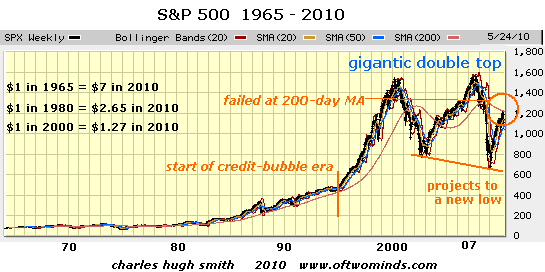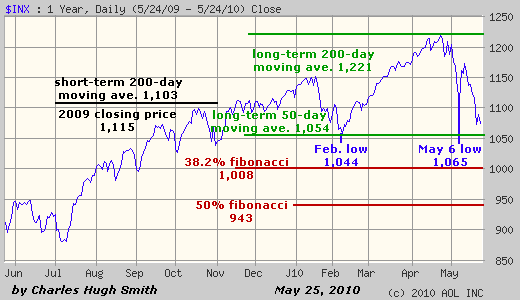Stocks Due for a Bounce, But Long Term....
by Charles Hugh Smith
My apologies for readers who tire of charts--but please look at the first one. As always, please read the HUGE GIANT BIG FAT DISCLAIMER below to refresh your awareness that this is not investment advice, it is merely the meanderings of an amateur observer.
This is a chart of the S&P 500 from 1965, when I was a lad of 12 and the Vietnam War was escalating, to the present, when tens of thousands of U.S. combat and support troops are stationed in "hot" war zones in Iraq and Afghanistan (not that we on the home front hear much about the wars).
I promise this will be relatively painless:

There are eight very simple things that pop out of this chart:
1. The stock market is a stupendous bubble, completely out of touch with the first 35 years depicted on the chart.
2. The bubble's ramp-up began in 1995, when the tech bubble expanded after a flat 1994. The market more than tripled in a mere half-decade. That's a bubble.
3. The bubble burst in 2000 but did not return to its starting place as is typical with classic bubbles--that is, it didn't retrace back to 400, but clung to 800--still a bubblicious height when compared to the previous 40 years.
Why did this occur? The Federal Reserve went all-in to inflate a new credit/asset bubble, this time in housing. Americans extracted trillions of dollars in "free money" from their bubbling houses and spent it like drunken sailors, saving nothing.
4. This unprecedented (essentially) zero interest rate policy, extreme liquidity and the orgy of fraud, leverage and embezzlement unleashed by lax/non-exisstent oversight created bubbles in real estate and stocks (profits exploded from all that "free money" being squandered).
5. The wheels fell off the credit/fraud/housing bubble in 2007.
6. The market hit a lower low, far exceeding the last post-bubble low. Technically, that projects to the next low being much lower than 2009's bottom of 667.
7. The bubble will not complete until it retraces to its starting point around SPX 400. With the SPX at 1,090 as I type, that would imply a 65% drop from today's levels.
8. The 2009-2010 rally failed right at the 200-day moving average--a key failure suggesting weakness ahead.
(Since the chart reflects nominal price, that is, not adjusted for inflation, I've provided some inflation numbers from the Bureau of Labor Statistics. So $1 in 1965 is roughly equivalent to $7 today, and $1 in 1980 is $2.65 in current dollars. Thus the SPX at 150 in 1980 would be around 400 in today's dollars.)
We also see this failure on an intermediate-term chart of the SPX from 2000 to 2010:

Notice how the 50-day moving average (MA) crossed above the long-term 200-day MA in the last post-bubble rally which began in 2003. Observe that the 50-day MA never even got close to the 200-day MA in this post-bubble rally--suggesting this rally was a sprint (juiced by Fed-supplied steroids) with no legs.
The negative alarms are weighty:
- The SPX has crashed through the short-term 20-day moving average (MA) of 1,140, the 50-day MA of 1,167 and the 200-day MA of 1,103. The SPX has broken below the "flash crash" May 6 low of 1,065.
- The SPX has broken below its 2009 closing price of 1,115.
These breaks below key technical support levels are the classic definition of a market breakdown, and they should be respected.
The MACD and both the 20-day and 50-day MAs are rolling over. This is not evidence of a "new Bull market" or a "nascent recovery."
The case for a smart rebound is as follows. Here is a chart which illustrates the confluence of various levels of support and the various levels of resistance which now act as "attractors" to price. That is, the market tends to rebound to its 20-day MA and its 50-day MA. If it fails to exceed these price levels then it typically rolls over and falls to new lows.

Technically, there are reasons to expect a bounce off the 1,040-1,050 level, and a return to at least the 1,100 mark: there is a confluence of support in the SPX chart around 1,000 – 1,054 level, right where the market is chopping now.
Not only is 1,000 a key psychological barrier—market players are drawn to round numbers, regardless of other factors—but the key 38.2% Fibonacci retracement line rests at 1,008. (The key Fibonacci ratios are 23.6%, 38.2%, 50%, 61.8% and 100%.)
The February low of 1,044 is close to the "flash crash" low of 1,065, and the l ong-term 50-day moving average rests right between those support levels at 1,054.
Those lines offer multiple sources of technical support.
Above, the short-term 200-day moving average at 1,103 beckons, as does the 20-day moving average at 1,140 and the 50-day MA at 1,167.
Even if the market has hit its highs for the year, it can be expected to rebound off key support levels. Technically, a strong case can be made for the market to find support at current levels (the SPX at around 1,054 intraday) and then bounce about 100 points to the 1,140 – 1,160 level.
Beyond that, we shall have to wait and see.
By way of disclosure: I bought calls and shares of SSO, a long-side leveraged ETF on the SPX yesterday when the SPX was 1,050.
HUGE GIANT BIG FAT DISCLAIMER: Nothing on this site should be construed as investment advice or guidance. It is not intended as investment advice or guidance, nor is it offered as such. It is solely the opinion of the writer, who is NOT an investment counselor/professional. All the content of this website is solely an expression of his personal interests and is posted as free-of-charge opinion and commentary. If you seek investment advice, consult a registered, qualified investment counselor (As with any other professional service, confirm their track record and referrals).
DailyJava.net is now open for aggregating our collective intelligence.
Order Survival+: Structuring Prosperity for Yourself and the Nation and/or Survival+ The Primer from your local bookseller or from amazon.com or in ebook and Kindle formats.A 20% discount is available from the publisher.
Of Two Minds is now available via Kindle: Of Two Minds blog-Kindle
| hank you, Andrew W. ($10), for your much-appreciated generous contribution to the site-- I am greatly honored by your support and readership. | Thank you, Marcena Y. ($25), for your extremely generous contribution and kind words of encouragement-- I am greatly honored by your support and readership. |



























